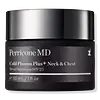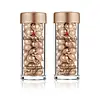What's inside
What's inside
 Key Ingredients
Key Ingredients

 Benefits
Benefits

 Concerns
Concerns

No concerns
 Ingredients Side-by-side
Ingredients Side-by-side

Water
Skin ConditioningHydrogenated Polyisobutene
EmollientIsononyl Isononanoate
EmollientGlycerin
HumectantPropanediol
SolventAcetyl Carnitine Hcl
Skin ConditioningDimethyl Mea
BufferingCetearyl Alcohol
EmollientNiacinamide
SmoothingJojoba Esters
EmollientHydrogenated Vegetable Glycerides
EmollientDimethicone
EmollientGlycolic Acid
BufferingPEG-100 Stearate
Glyceryl Stearate
EmollientPhosphatidylcholine
EmulsifyingTetrahexyldecyl Ascorbate
AntioxidantPalmitoyl Tripeptide-5
Skin ConditioningXanthan Gum
EmulsifyingEchium Plantagineum Seed Oil
Skin ConditioningAcetyl Tyrosine
Skin ConditioningSqualane
EmollientPhytic Acid
Ethylhexylglycerin
Skin ConditioningHelianthus Annuus Seed Oil
EmollientTocopherol
AntioxidantLecithin
EmollientZinc Gluconate
Skin ConditioningMagnesium Aspartate
Skin ConditioningGlycine Soja Oil
EmollientCaffeine
Skin ConditioningTetradecyl Aminobutyroylvalylaminobutyric Urea Trifluoroacetate
Skin ConditioningSodium Hyaluronate
HumectantPalmitoyl Carnitine
Skin ConditioningCopper Gluconate
Skin ConditioningRosmarinus Officinalis Leaf Extract
AntimicrobialCarrageenan
Disodium EDTA
Hydroxyethyl Acrylate/Sodium Acryloyldimethyl Taurate Copolymer
Emulsion StabilisingCetearyl Glucoside
EmulsifyingSclerotium Gum
Emulsion StabilisingCaprylyl Glycol
EmollientPolysorbate 60
EmulsifyingPhenoxyethanol
PreservativePotassium Sorbate
PreservativeParfum
MaskingSilica
AbrasiveCI 77891
Cosmetic ColorantCI 77491
Cosmetic ColorantSodium Benzoate
MaskingSodium Metabisulfite
AntioxidantBenzyl Benzoate
AntimicrobialLimonene
PerfumingWater, Hydrogenated Polyisobutene, Isononyl Isononanoate, Glycerin, Propanediol, Acetyl Carnitine Hcl, Dimethyl Mea, Cetearyl Alcohol, Niacinamide, Jojoba Esters, Hydrogenated Vegetable Glycerides, Dimethicone, Glycolic Acid, PEG-100 Stearate, Glyceryl Stearate, Phosphatidylcholine, Tetrahexyldecyl Ascorbate, Palmitoyl Tripeptide-5, Xanthan Gum, Echium Plantagineum Seed Oil, Acetyl Tyrosine, Squalane, Phytic Acid, Ethylhexylglycerin, Helianthus Annuus Seed Oil, Tocopherol, Lecithin, Zinc Gluconate, Magnesium Aspartate, Glycine Soja Oil, Caffeine, Tetradecyl Aminobutyroylvalylaminobutyric Urea Trifluoroacetate, Sodium Hyaluronate, Palmitoyl Carnitine, Copper Gluconate, Rosmarinus Officinalis Leaf Extract, Carrageenan, Disodium EDTA, Hydroxyethyl Acrylate/Sodium Acryloyldimethyl Taurate Copolymer, Cetearyl Glucoside, Sclerotium Gum, Caprylyl Glycol, Polysorbate 60, Phenoxyethanol, Potassium Sorbate, Parfum, Silica, CI 77891, CI 77491, Sodium Benzoate, Sodium Metabisulfite, Benzyl Benzoate, Limonene
Dicaprylyl Carbonate
EmollientCoco-Caprylate/Caprate
EmollientDimer Dilinoleyl Dimer Dilinoleate
EmollientTetrahexyldecyl Ascorbate
AntioxidantTocopheryl Acetate
AntioxidantC12-15 Alkyl Benzoate
AntimicrobialCaprylic/Capric Triglyceride
MaskingCeramide NP
Skin ConditioningCeramide Ns
Skin ConditioningDiethylhexyl Syringylidenemalonate
Skin ProtectingGlyceryl Dioleate
EmollientHelianthus Annuus Seed Oil
EmollientOlea Europaea Fruit Oil
MaskingPersea Gratissima Oil
Skin ConditioningPhytosphingosine
Skin ConditioningPhytosterols
Skin ConditioningPropylene Glycol Dicaprylate/Dicaprate
EmollientSclareolide
MaskingTocopherol
AntioxidantTriolein
Skin ConditioningPhenoxyethanol
PreservativeDicaprylyl Carbonate, Coco-Caprylate/Caprate, Dimer Dilinoleyl Dimer Dilinoleate, Tetrahexyldecyl Ascorbate, Tocopheryl Acetate, C12-15 Alkyl Benzoate, Caprylic/Capric Triglyceride, Ceramide NP, Ceramide Ns, Diethylhexyl Syringylidenemalonate, Glyceryl Dioleate, Helianthus Annuus Seed Oil, Olea Europaea Fruit Oil, Persea Gratissima Oil, Phytosphingosine, Phytosterols, Propylene Glycol Dicaprylate/Dicaprate, Sclareolide, Tocopherol, Triolein, Phenoxyethanol
Ingredients Explained
These ingredients are found in both products.
Ingredients higher up in an ingredient list are typically present in a larger amount.
Helianthus Annuus Seed Oil is the oil derived from the seeds of a Sunflower. Sunflower seed oil is non-fragrant. It is an emollient, meaning it helps to soften the skin.
Sunflower seed oil contains many fatty acids. The fatty acids found in sunflower seeds include (from highest amount to least): linoleic acid, myristic acid, palmitic acid, stearic acid, arachidic acid, oleic acid, and linolenic acid.
These fatty acids help the skin create ceramides. Ceramides play a role in repairing the skin barrier.
Helianthus Annuus Seed Oil helps moisturize the skin. This in turn helps the skin look more rejuvenated and smoother.
Sunflowers are rich in vitamin E.
Historians believe Indigenous cultures of North America domesticated sunflowers before corn. Thus they relied on sunflower oil for a variety of uses. One such use is moisturizing skin and hair.
Sunflower seed oil may not be fungal acne safe. We recommend speaking with a professional if you have any concerns.
Learn more about Helianthus Annuus Seed OilPhenoxyethanol is a preservative that has germicide, antimicrobial, and aromatic properties. Studies show that phenoxyethanol can prevent microbial growth. By itself, it has a scent that is similar to that of a rose.
It's often used in formulations along with Caprylyl Glycol to preserve the shelf life of products.
Tetrahexyldecyl Ascorbate (THD) is a stable and oil-soluble form of Vitamin C.
THD is special in that it has the ability to travel deeper into skin than traditional ascorbic acid while maintaining the same skin benefits (double win!).
Because it’s oil-soluble, THD dives deep into your skin’s fatty layers (think ceramides and cholesterol) to fight off the kind of free radicals that mess with your skin barrier. This makes it a great pair with water-based vitamin C (ascorbic acid) that mainly works on the surface.
Even at just 0.1%, THD is already showing great antioxidant activity. When used up to 2%, it helps keep your skin happy and calm, especially when it’s stressed from pollution or sun.
Want to fade dark spots or tackle hyperpigmentation? You’ll want 5% or more. Pairing it with brightening buddies like niacinamide or licorice root gives even better results. One study even used 30% THD with other brighteners and saw real results on stubborn discoloration, even in melasma-prone skin.
A note on THD: It’s has a slightly silky, oily texture and usually shows up colorless or pale yellow (though the exact shade can vary by supplier).
While you can sneak it into water-based formulas, it really shines when paired with silicones or oils, which help your skin soak it up better.
THD is pretty stable, but it’s still vulnerable to degradation like ascorbic acid. Too much light or heat (above 113°F / 45°C) can break it down over time. Go for dark and opaque packaging that keeps it safe and shady!
Read more about other types of Vitamin C:
Learn more about Tetrahexyldecyl AscorbateTocopherol (also known as Vitamin E) is a common antioxidant used to help protect the skin from free-radicals and strengthen the skin barrier. It's also fat soluble - this means our skin is great at absorbing it.
Vitamin E also helps keep your natural skin lipids healthy. Your lipid skin barrier naturally consists of lipids, ceramides, and fatty acids. Vitamin E offers extra protection for your skin’s lipid barrier, keeping your skin healthy and nourished.
Another benefit is a bit of UV protection. Vitamin E helps reduce the damage caused by UVB rays. (It should not replace your sunscreen). Combining it with Vitamin C can decrease sunburned cells and hyperpigmentation after UV exposure.
You might have noticed Vitamin E + C often paired together. This is because it is great at stabilizing Vitamin C. Using the two together helps increase the effectiveness of both ingredients.
There are often claims that Vitamin E can reduce/prevent scarring, but these claims haven't been confirmed by scientific research.
Learn more about Tocopherol